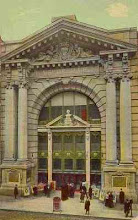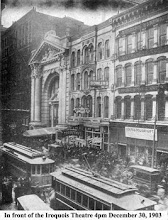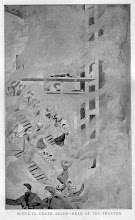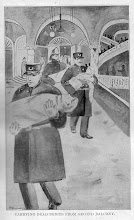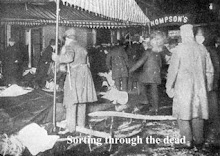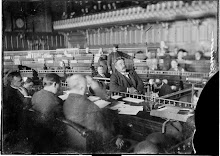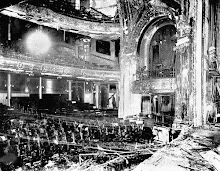Chicago at the turn of the century boomed with a wildly-growing population and unequalled wealth. The city remained the fastest growing city in the nation and Americans knew it as the “Second City” and “the Gateway to the West.” The city had become infamous for its architecture, especially its skyscrapers, signs of unprecedented wealth. Each building that went up towered over the previous monster as investors driven by greed attempted to wring every ounce of value out of their investments. A corrupt city government of Chicago, in particular, Mayor Carter Harrison made this unbridled capitalism possible. Corruption and vice filled the metropolis during the first quarter of the twentieth century. Writer Nat Brandt stated that “despite all the excitement about the city’s phenomenal growth and economic health, Chicago remained a city of corruption, built as much by greed as it was by steel and cement.”[3] Chicago construction companies remained infamous for the poor quality of their theater construction and for cutting corners at every opportunity. The construction of the Iroquois Theater remained “a matter of business-as-usual.”[4] The environment of the city allowed theater owners Harry J. Powers and William J. Davis to hire the George H. Fuller Construction Company to produce the much-anticipated, Iroquois Theater.
Architect Benjamin H. Marshall designed the Iroquois with grandeur in mind. The theater had an “imposing entrance, 60 feet high, leading into a brilliantly decorated lobby…expected to catch many strangers before they head further up the street.”[5] The theater lacked nothing in the way of appearance and comfort. The theater “did, indeed, live up to the promise of its being the ‘most beautiful temple of the drama’...the entrance to a classical Greek place of worship.”[6] Theatergoers witnessed a building which seemed to resemble the breathtaking luxury of European architecture and design rather than that of an American boomtown. The builders elaborately decorated the lobby with granite columns and gold and jeweled fixtures. While builders constructed the exterior of the structure with concrete and nonflammable materials, the interior of the theater consisted of highly flammable woods and textiles. The construction process had taken longer than expected as the builders ran into more delays. As the holiday season approached, the owners pressured the George H. Fuller Company to finish the construction even if it meant that they open the theater with only the essentials. Powers and Davis would open the theater before the busy season on November 23, 1903 with only the necessities. The theater opened with the elegant lobby, the luxurious seating arrangement, coat rooms, and a men’s smoke room, yet lacked effective fire extinguishers and deterrents as well as many other safety features, such as a fire alarm box. The building opened as a structural equivalent to many other theaters in Chicago as it was sufficiently decorated and visually appealing yet hopelessly unprepared for an emergency. According to the New York Times, the theater “was undoubtedly the safest theatre in Chicago.”[7] As Merriam would discover, the theater proved fire-proof, unfortunately only on the outside.
The theater commenced its production of Mr. Bluebeard, a musical comedy starring the actor Eddie Foy. The theater experienced far less than desired preliminary attendance number but picked up as the holidays rolled around and the schools went on break. By December 30, the theater owners had to initiate the sale of standing room tickets. The fact that the occupation of these free spaces went against the city’s fire code did not stop the theaters from this practice. The theater overflowed with an audience of more than 2,000 people consisting mostly of women and children. The New York Times reported that “Only once a year could such an audience have gathered; only once in all twelve months could so many children have been collected within the walls of the theater.”[8] Shortly after the beginning of the second act, around 2:30 in the afternoon, an arc light sparked and set the stage for one of the worst preventable disasters in Chicago’s history.
The light, located above the stage had a large covering over the bulb yet exposed wires for mobility. The wires sparked and caught the muslin draperies on fire while the lighting technician had wandered away from his post. Some audience members noticed the small blaze yet most remained calm and unperturbed or simply unaware. Stagehands attempted to put out the flames quickly by batting at them with bare hands and throwing Kilfyre, a primitive fire extinguishing device, onto them. Despite the crew’s best efforts, the fire spread as flaming drapery fell onto combustible scenery on the stage floor. As the smoke and flames eventually poured into the front of the theater, the entire audience finally took notice of the danger. On stage, Foy came forward in an effort to calm the crowd and to facilitate a safer exit. After handing his son, who had attended the show, to another stagehand in the process of exiting the building to the rear of the stage, Foy addressed the audience. He later remembered his speech, “[I] ran out on the footlights to the audience. When I did they were in a sort of panic, as I thought, and what I said exactly I don't remember, but this was the substance my idea was to get the curtain down and quietly stop the stampede.”[9] The builders had equipped the theater with a fire-retardant asbestos curtain which operators could lower between the stage and the audience in order to block the spread of the flames. Foy remembered that he yelled, “‘Drop the curtain and keep up your music.’ I didn't want a stampede, because it was the biggest audience I ever played to of women and children.”[10] Foy instructed the stagehands to drop the curtain while commanding orchestra conductor Herbert Dillea to keep playing so as to pacify the crowd. Foy remained on stage expecting the curtain to fall behind him yet to his dismay, the curtain snagged on the right side of the stage and therefore neither side could descend to the floor. Foy requested that everyone “Don't get excited…Sit down; it is all right; don't get excited.”[11] Numerous audience members now started to leave while many obediently sat in their seats as Foy had requested of them. The actor then looked toward the curtain to find out why it had not come down. Upon inspection, the curtain “was blocked in its descent by a steel reflector”[12] and had begun to burn on the edges. As more of the stage burned and groups of people started to converge on the exits, Foy, and the last of the orchestra members, made a quick exit. Shortly after Foy’s departure, a stagehand got the double doors used to remove scenery open. This large door, the second stage door opened, let in the eight degree Chicago wind which fueled the growing fire and initiated a vortex of smoke and fire which sped straight towards the front of the theater.
Marshall had studied fire safety before designing the Iroquois and had recommended the appropriate security measures. His plans included a glass skylight with vents that in the instance of a fire would remove the resulting poisonous gases and act as a flue and draw the flames upward. He also provided vents behind the dress circle on the mezzanine and behind the gallery seating. The owners had installed both of these safety precautions yet had not had the workers remove the wiring from the skylight vents which had kept them closed and secure during transport to the theater. The skylight therefore, did not open but instead, in conjunction with the vents in the audience, to create a cyclone of air which carried the fire, the smoke, and the gases under the curtain and over the orchestra level parquet seating into the faces of those in the balconies. Those caught directly in the way of the burning air died instantly of asphyxiation while others survived long enough to make it to the exits and have some hope of survival. Brandt noted:
"The sudden draft was so unexpected that many people were caught in their seats and asphyxiated. Those who had abandoned their seats before then, searching for a way out, were gasping, their throats on fire, their hair and clothing singed or burning. Panicking, many could not find a way to escape. Those who managed to make it to a stairway found themselves caught in a human traffic snarl. Hundreds died."[13]
At this point, directly after the fire had instantaneously spread into the theater front, the horror began.
The burning deaths now occurred as the fire raged in the seats while audience members trampled each other in a rush for exits now only lit by raging flames. By this point, most of the actors, stagehands, and people in the parquet had gotten out of the theater and into the blistering cold of the Chicago streets. Those still left inside in the upper levels would make up the bulk of the death toll. Most of these men, women, and children ran for the exits the way they had entered the theater while a few fortunate others found the numerous fire exits on the north wall of the building. Powers and Davis had covered these doors with drapery in order to better the appearance of the new construction and later claimed that they had ordered exit signs which never arrived. Most of the people inside the inferno had no idea that these exits even existed. Those who did find the doors found them locked with a foreign device which they could not figure out. The owners had locked the fire exits with European bascule locks, “a device popular in European theaters but virtually never used in American playhouses and totally unknown in Chicago theaters.”[14] Only one person, an usher, knew how to work the locks and he had only found out himself out of curiosity. A few of the men were able to rip the entire locking mechanism off of the doors and force them open but the majority of the doors remained closed and ineffectual. Those who fled to the staircases through which they entered the theater found these walkways blocked by accordion gates and padlocked. The owners locked these gates in order to prevent those who had bought cheap tickets from sneaking down into the expensive seats. The unfortunate people who reached these gates found themselves crushed up against the blockades by panicking theatergoers. The fleeing people trampled women and children as they climbed over each other to get away from the spreading flames and gathering poison gas. Some of the men found themselves able to climb over the doors but remained unable to help the others inside who literally began dropping dead from asphyxiation and in some cases, burning alive.
Outside the theater, a crowd had formed to watch the fire and the victims fleeing out of the front doors. As they watched, panicked theatergoers eventually exited the building through the fire escapes to the north of the building. The first to get on the landings of the fire escapes noticed that the ladders had frozen in an up position. Therefore, men had to jump down ten or fifteen feet and catch or break the fall of others less capable. One of these men, a retired baseball player named Frank Houseman continued catching women and children as they jumped off of the fire escape, “But then others higher up on the fire escape began jumping, too. Houseman pulled bodies out of the way as people plunged from above. One man fell on three bodies, started to get up and then was struck down by a woman who fell on him.”[15] When the situation in the alleyway below the fire escapes became too dangerous, firemen with jump nets replaced these courageous men. Unfortunately, jumpers had trouble seeing the black nets through the smoke billowing out of the doors and windows of the theater. Many landed near the nets as the firemen tried to react to the large volume of falling bodies. Eventually and inevitably, the flow of jumpers slowed and then stopped. By this time, fire fighters appeared in the lobby and made their way into the theater.
When firefighters arrived at the Iroquois, they encountered throngs of people crushing against the glass lobby doors. Upon further inspection, the firemen found three out of four of the doors locked. They broke through the glass and allowed the crowd to move into the street as they passed through to get inside the playhouse. They later found out that the owners had locked the doors to keep people from sneaking in while the staff sold tickets to latecomers. This action ended up affecting the outflow of victims fleeing the fire and creating a bottleneck where the crowd gathered and crushed people against the doors. Fire Chief William H. Musham later commented, “It seems to me that there is nothing in the world, at least nothing that I can think of at the present moment, that can save lives when a thousand persons try to pass through one doorway at one time.”[16] After the firefighters got the doors opened, they entered the horror of the theater. Despite saving a few stragglers who somehow survived the ordeal, most only to die later of inhalation and their burn injuries, the firefighters worked primarily to remove the bodies of the dead. They found piles of bodies at each gate sometimes seven or more deep. Workers removed the wounded and the dead to nearby buildings including a Marshall Field & Co.’s store and Thompson’s Restaurant, adjacent to the Iroquois. Doctors, nurses, and clergymen from around the city volunteered their services and filled the restaurant and the other buildings. “An improvised hospital in Marshall Field & Co.’s store was crowded to its capacity during the fire. The west room and employees’ setting room on the eighth floor were filled within thirty minutes after the work of rescue began. The maids in charge of the toilet rooms acted as nurses.”[17] The restaurant grew so busy that a stream of men carrying victims in one door and exiting the other did not cease for hours. It soon became clear that the fire had doomed a majority of the survivors due to inhalation and the bodies on the back wall of the restaurant piled up. As the body count grew, so did public resentment.
The fire had not had a day to cool before relatives of those lost came looking for blood. Brandt stated that “One thing was clear. Justice demanded that someone or some persons had to be held accountable for the tragedy.”[18] Those who thought themselves in the crosshairs attempted to shift the blame by throwing accusations at others. “Charges and countercharges flew back and forth to such a degree that it was impossible to pinpoint any single culprit. Everyone put the blame on someone or something else. No one accepted responsibility.”[19] Coroner John Traeger led a jury of six businessmen to investigate the fire. A grand jury would also have to look into the matter. The police quickly arrested three members of the Iroquois staff, including stage manager William Carleton. The searched for twenty-six others from Iroquois carpenters to managers, “charged with being accessories to manslaughter.”[20] These men “had packed their trunks and would have been out of the city had not the police arrested them.”[21] Even corrupt Mayor Harrison commissioned an investigatory committee to investigate the incident. The coroner’s jury stated that it would not recommend punishment for anyone but leave that up to the state attorney’s investigation. The jurors did recommend the arrest of Iroquois owner Will Davis, Building Commissioner George Williams, Building Inspector Edward Laughlin, Fire Chief William Musham, Iroquois fireman William Sallers, stage manager James E. Cummings, and the arc light operator William McMullen. They recommended that the state charge these men with manslaughter for negligence. They also thought that Mayor Harrison should be held responsible for “a lamentable lack of force”[22] in seeing to the city ordinances implemented. A judge quickly threw out the charges against Davis, Powers, and Williams which brought criticism and suspicion from the city and its enraged inhabitants. The judge also questioned the responsibility of Cummings and McMullen to keep the entire building up to the city’s fire code. The grand jury held its session to much anticipation from Chicagoans. It indicted five people including Will Davis, Iroquois treasurer and assistant manager Thomas J. Noonan, and stage manager James E. Cummings for manslaughter. The grand jury indicted Building Commissioner Williams and Building Inspector Edward Laughlin for malfeasance. They intended to start the trials right away.
During the proceedings, the defense proved almost a conspiracy. The defense team came up with an infuriatingly endless series of delays before finally proposed a motion for a change of venue. The fair share of the brilliance that the defense exhibited in the trials belonged to the legendary labor attorney Clarence Darrow. Darrow “mistrusted the public’s desire to find a scapegoat…he believed that it was not ‘just to lay the sins of a generation upon the shoulders of a few.’”[23] While not personally appearing in court, he came up with an astonishing defense strategy. He knew that by changing the venue for Noonan and Cummings but not Davis, they would be tried separately and much of the evidence of negligence could not be brought against Davis since it might prejudice the second trial. Davis’ trial finally commenced in Danville, Illinois in March of 1907, three years after the fire. The newly hired legal counsel Levy Mayer waited until shortly after the prosecution’s opening statement before objecting to the entire proceedings based on the invalidity of Chicago’s ordinances. He justified his objection with a damage suit in which he had helped represent the defense in November of 1905. In this case, the court ruled the city’s ordinances invalid because its writers had worded them incorrectly. Judge E. R. E. Kimbrough suspended the proceedings for a week while Mayer and the prosecuting attorneys discussed the matter. The judge finally ruled in favor of the defense and therefore defeated the charges against the other defendants since their trials involved the same ordinances. Since the trial had started, the state could not indict Davis again on the same charges as this would constitute double jeopardy. “As a result, implausible as it seems, no one was ever tried, no one ever punished, for the loss of 602 lives,”[24] wrote Brandt.
The civil suits proved just as strange. The judges ruled that the city of Chicago could not be held responsible for every disaster that takes place within its limits. The courts held the George H. Fuller Company solely reliable and the company settled five years after the initial disaster for $750 for each claim. These parties originally sued for $10,000 each but the company only had to pay out $29,750 in the end. Writer Anthony P. Hatch stated, “It is impossible to know if, or how, those cases were settled, because many were apparently dismissed for technical reasons or because lawyers whose compensation was based on a successful outcome did not believe the effort was worth their time, especially if they had to go up against people like Levy Mayer and other powerful attorneys representing the Theatrical Trust.”[25] It appeared that the theatergoers deaths in the fire had come to nothing until Chicago’s new ordinances came out.
The new rules specified a numerous changes to the standards of fire safety. Each balcony had to have separate entrances and exits. All hallways had to be at least four feet wide and the aisles at least thirty inches. The new ordinances required thirty-two inches between the rows and the fire exits unobstructed from view, marked with signs, and unlocked while occupied. The city required the theaters to paint scenery with non-flammable chemicals and to make all vents activated with closed-circuit battery from within a fire-proof fireman’s station. The newly formed Iroquois Memorial Association vowed to overlook these ordinances in the playhouses and demanded that the city honor those who had perished in the fire. The city declared December 30 a holiday called Mercy Day in honor of those people who helped the victims of the fire. Thomas Quigley wrote a song called “The Iroquois Fire” and Mathew Goodwin and Edward Stanley wrote “The Burning Iroquois” to commemorate the disaster. As a final testament to the Iroquois victims, the Iroquois Memorial Association gathered the funds to erect the Iroquois Memorial Hospital which eventually ended up treating local tuberculosis patients. The city could finally rest with the knowledge that they had honored the victims and taken sufficient precautions against the danger of similar catastrophes.
In the end, 602 people perished due to the fire at the Iroquois Theater on December 30, 1903. The courts punished no one and only the construction company ever had to pay a cent to the victims’ families. On the other hand, the residents of the city came together in the face of the disaster and helped their fellow Chicagoans. The city revolutionized their fire-prevention ordinances and gained a healthy respect for the hazard. The Iroquois Theater fire had a profound and lasting effect upon Chicago as well as the rest of the nation. The Architect Marshall stated, “I’ll never allow another theatre to be built with a stick of wood in it.”[26] Many of the ordinances still exist or set the precedence for many of today’s fire-prevention regulations. As time goes on, the people of Chicago have not and will not forget “the worst theater fire disaster in U.S. history.”[27]
Notes:
[1] “Calls The Theater Fire-Proof,” New York Times, December 31, 1903.
[2] “Chicago Silently Mourns Its Dead,” New York Times, January 1, 1904.
[3] Nat Brandt. Chicago Death Trap: The Iroquois Theatre Fire of 1903 (Carbondale, IL: Southern Illinois University Press, 2003), 108.
[4] Brandt 108.
[5] Brandt xv.
[6] Brandt 13-14.
[7] “Say Law was Ignored,” New York Times, January 1, 1904.
[8] “Over 500 Die in Chicago Theatre,” New York Times, December 31, 1903.
[9] Marshall Everett and Samuel Fallows. Chicago’s Awful Theater Horror (Chicago, Memorial Publishing Co., 1904), 222.
[10]Everett 222.
[11]Everett 222.
[12]“Why Curtain Stuck,” New York Times, January 3, 1904.
[13]Brandt 52.
[14]Brandt 44.
[15]Brandt 45.
[16]“Fire Chief’s Suggestion,” New York Times, January 1, 1904.
[17]“Caring For The Injured,” New York Times, December 31, 1903.
[18]Brandt 121.
[19]Brandt 114.
[20]“Twelve Arrests Follow Disaster,” New York Times, January 1, 1904.
[21]“Twelve Arrests Follow Disaster,” New York Times, January 1, 1904.
[22]Brandt 126.
[23]Brandt 129.
[24]Brandt 133.
[25]Anthony P. Hatch, Tinder Box: The Iroquois Theatre Disaster 1903 (Chicago: Academy Chicago Publishers, 2003), 204-205.
[26]“Theatre’s Architect Talks,” New York Times, December 31, 1903.
[27]Clerk of the Circuit Court of Cook County, Illinois, “Disaster: The Iroquois Theater Fire,” http://www.cookcountyclerkofcourt.org/?section=RecArchivePage&RecArchivePage=iroquois_theater.
Image Contributions:
“The Iroquois Theater” http://www.inficad.com/~ksup/iroquois.html
“The Lobby” http://www.rootsweb.ancestry.com/~ilcook/rdata/history/ChgoTheaterDisaster/ChgoTheaterDisaster.htm
“Program” http://chicagology.com/notorious-chicago/iroquois-theatre/
“Stage When the Fire Started” http://www.inficad.com/~ksup/iroquois0.html
“Smoke From the Iroquois” http://chictrib.image2.trb.com/chinews/media/photo/2008-08/41632153.jpg
“Fire Street Scene” http://www.wayneturney.20m.com/iroquoisfire.htm
“Panic and Locked Doors” http://www.rootsweb.ancestry.com/~ilcook/rdata/history/ChgoTheaterDisaster/ChgoTheaterDisaster.htm
“Escaping into ‘Death Alley’” http://www.rootsweb.ancestry.com/~ilcook/rdata/history/ChgoTheaterDisaster/ChgoTheaterDisaster.htm
“Rescuers Removing Bodies” http://www.rootsweb.ancestry.com/~ilcook/rdata/history/ChgoTheaterDisaster/ChgoTheaterDisaster.htm
“Sorting the Bodies” http://www.wayneturney.20m.com/iroquoisfire.htm
“In Line for the Morgue” http://www.inficad.com/~ksup/iroquois0.html
“Investigation” http://www.inficad.com/~ksup/iroquois.html
“Harrison in Court” http://homicide.northwestern.edu/context/timeline/1904/359/
“Sheet Music to ‘The Burning of the Iroquois’” http://webapp1.dlib.indiana.edu/metsnav/inharmony/navigate.do?oid=http://fedora.dlib.indiana.edu:8080/fedora/get/iudl:273113/METADATA
“Wreckage” http://chictrib.image2.trb.com/chinews/media/photo/2008-08/41632153.jpg
“Memorial” http://graveyards.com/IL/Cook/montrose/iroquois.html
